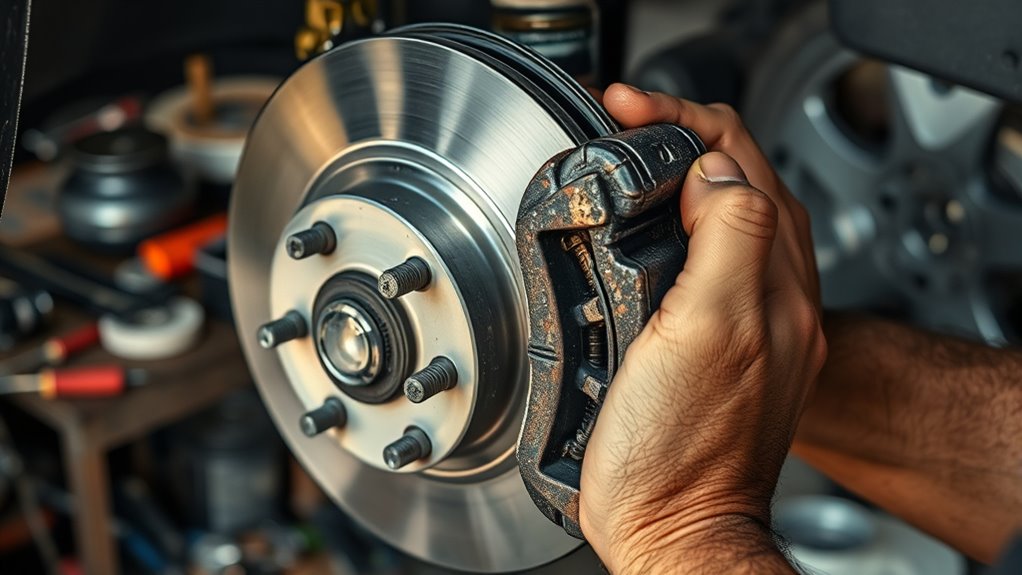Brake repair costs vary depending on what’s needed, like replacing brake pads ($150–$300 per axle), fluid flush ($70–$150), or rotor work. To save, schedule regular inspections, compare quotes, and select quality parts. Ignoring signs can lead to more expensive damage. Staying on top of brake maintenance ensures safety and those costs stay manageable. If you want tips on keeping your repairs affordable and ensuring safe braking, keep exploring options for savings.
Key Takeaways
- Brake pad replacement costs typically range from $150–$300 per axle, depending on parts and vehicle make.
- Regular maintenance like brake fluid flushes ($70–$150) helps prevent costly repairs and prolongs brake system life.
- Signs such as squealing, soft pedal, or decreased stopping power indicate the need for immediate inspection and repair.
- Comparing quotes, choosing quality parts, and bundling services can significantly reduce repair expenses.
- Timely professional inspections and early repairs prevent further damage, saving money and ensuring vehicle safety.

Your brake system is crucial for safe driving, and when it starts to fail, you’ll need to get it repaired promptly. Brake repair costs can vary depending on what’s wrong with your system, but understanding the essentials helps you prepare financially. One common service you might need is brake pad replacement. Over time, brake pads wear down from friction, and if you ignore the signs—like squealing sounds or decreased stopping power—you risk damaging other components like rotors, which can drive up repair costs. Replacing brake pads is generally affordable, often ranging from $150 to $300 per axle, but this depends on your vehicle make and the quality of parts used. Opting for high-performance or OEM parts can increase costs, but they often last longer and perform better.
Another key maintenance task is a brake fluid flush. Brake fluid is crucial for transferring force from your pedal to the brake components, and it absorbs moisture over time, which can lead to corrosion and reduced braking efficiency. A brake fluid flush involves draining old, contaminated fluid and replacing it with fresh fluid. Not only does this improve braking response, but it also extends the lifespan of your brake system. Expect to pay between $70 and $150 for a brake fluid flush, depending on your location and vehicle. Skipping this service can lead to brake failure or expensive repairs later, so it’s worth scheduling regularly. Regularly inspecting low light office plants can also help create a comfortable environment in your workspace, which may contribute to overall safety awareness, including vehicle maintenance.
When your brakes aren’t working properly, you might also need to think about other repairs such as rotor resurfacing or replacement, caliper repairs, or brake line fixes, which can add to your overall costs. To save money, keeping up with regular maintenance is key. Catching issues early often means smaller repairs and lower costs. For example, if you notice a soft brake pedal or a spongy feel, don’t delay in getting a professional inspection, which can identify whether you need a simple brake pad replacement or more extensive repairs.
Shopping around for service providers can also help you save. Check reviews and compare quotes from different shops; some may offer package deals that include brake pad replacement and brake fluid flush at a discounted rate. Additionally, investing in quality parts might seem costly upfront but can save you money long-term by reducing the frequency of repairs. Regular maintenance, timely repairs, and choosing the right parts and service options will keep your brake costs manageable and your vehicle safe on the road.
Frequently Asked Questions
How Often Should Brake Pads Be Replaced?
You should replace your brake pads typically every 25,000 to 70,000 miles, depending on your brake pad materials and driving habits. Heavier use or aggressive driving can wear pads faster, reducing your brake system lifespan. Regular inspections will help you catch wear early. If you notice squealing or reduced braking efficiency, it’s time for a replacement. Staying attentive guarantees your brakes stay reliable and safe.
Are Aftermarket Parts as Reliable as OEM?
You might worry that aftermarket parts aren’t as reliable, but many offer comparable durability and OEM compatibility. While some fear they’ll break sooner, quality aftermarket options undergo rigorous testing, ensuring they meet or exceed OEM standards. If you choose reputable brands, you get the benefit of saving money without sacrificing reliability. So, rest assured—aftermarket parts can be a dependable alternative, provided you do your research and select high-quality components.
Can I Repair Brakes Myself Safely?
You can repair your brakes yourself, but safety is key. Make sure you have the right DIY tools and follow safety precautions closely. If you’re experienced and confident, you can handle minor repairs like replacing brake pads. However, if you’re unsure or dealing with complex issues, it’s best to seek professional help. Always prioritize safety to avoid accidents or further damage. Proper tools and precautions guarantee a safe, effective brake repair.
What Are Signs of Impending Brake Failure?
You should watch for signs of impending brake failure, like a spongy brake pedal or unusual noises. If you notice brake fluid contamination, it can weaken braking power, while brake rotor warping causes vibrations when braking. These issues signal you need to get your brakes inspected promptly. Ignoring these signs risks brake failure, so stay alert and address problems early to make certain of your safety on the road.
How Long Does a Typical Brake Repair Take?
A typical brake repair usually takes about 1 to 3 hours, depending on what’s needed. If your brake fluid is contaminated or low, you’ll need a flush, which adds time. Rotor resurfacing can also extend the job, especially if the rotors are warped or scored. Your mechanic will check everything from brake pads to calipers, ensuring your brakes are safe and effective after the repair.
Conclusion
Think of your brake system as the steering wheel of your car’s safety ship. Ignoring small issues is like neglecting the rudder—eventually, you’ll find yourself off course or stuck in rough waters. Investing in timely repairs keeps your journey smooth and secure, just as a steady hand on the wheel guides you safely home. Stay proactive with brake maintenance, and you’ll navigate life’s roads with confidence and peace of mind.









